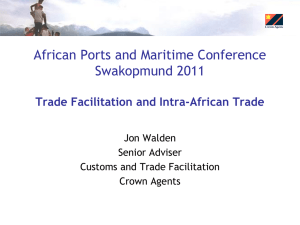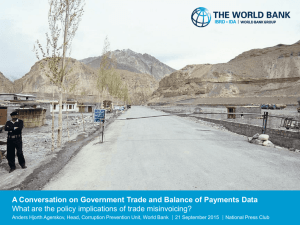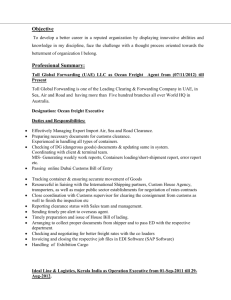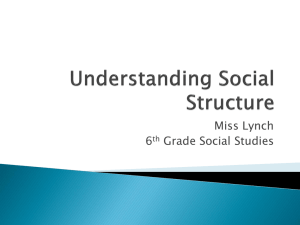Trade Facilitation and Competitiveness Dr Rose Marie Azzopardi
advertisement
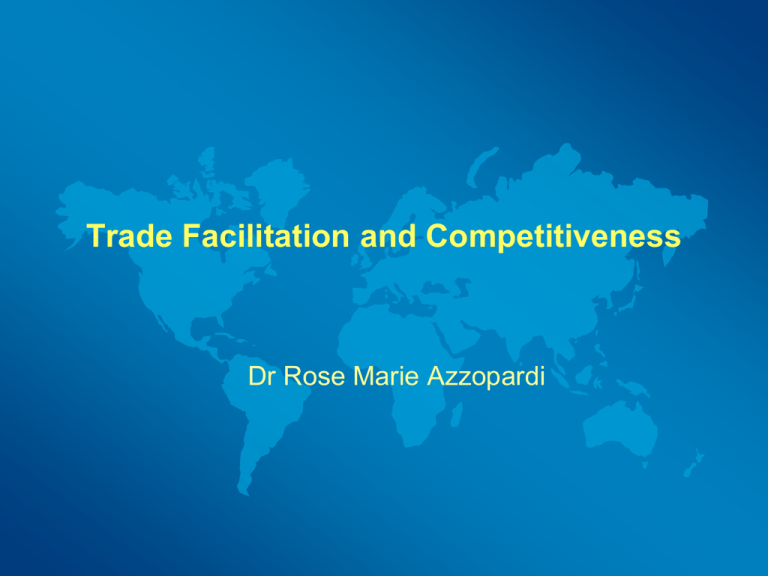
Trade Facilitation and Competitiveness Dr Rose Marie Azzopardi Outline of Presentation • • • • • • • • Defining trade facilitation Types of trade hindrances Trade facilitation and the WTO Costs and benefits of trade facilitation The state of play of specific countries Technical assistance and capacity building The role of easier trading for competitiveness Concluding remarks 2 Defining trade facilitation • “Facilitating trade is about streamlining and simplifying international trade procedures in order to allow for easier flow of goods and trade at both national and international level.” (OECD) “The simplification and harmonisation of international trade procedures (referring to) activities, practices and formalities involved in collecting, presenting, communicating and processing data required for the movement of goods in international trade”. (WTO)3 Principles • Transparency • Predictability • Non-discrimination • Simplification 4 Approaches • Harmonisation • Risk management • Automation • Best practice and experiences 5 Type of trade obstacles and restrictions • • • • • • • • Tariffs and non-tariff barriers Border measures Quotas Government bureaucracy Fees, licences, formal procedures Standards Health and safety regulations Technical regulations, product labelling 6 WTO • 1 August 2004 – July Package – Annex D • Trade facilitation one of four Singapore issues • Focus on clarifying and improving aspects of Articles of GATT 1994 • Article V – freedom of transit • Article VIII – fees and formalities • Article X – publication and administration of trade regulations (transparency) • “shall address the concerns of developing and least-developing countries related to cost implications of proposed measures” • In addition: • Technical assistance and capacity building • Cooperation between customs and other relevant bodies (for example one window system) 7 Yet apprehension exists • Fear of developing countries because of substantial investment in infrastructure and human resources • Especially as they need to compete with developed countries who mostly have such measures in place, which measures were developed according to own needs and priorities • For lesser developed countries revenue is derived from customs activities and other ancillary bureaucratic services 8 Ease of doing business in.... • • • • • • • • • Starting a business Dealing with construction permits Registering property Getting credit Protecting investors Paying taxes Trading across borders Enforcing contracts Closing a business 9 Trading across Borders...185 countries (2012) Indicator Best Performer Worst Performer Singapore Uzbekistan Documents to export (no.) 4 13 Time to export (days) 5 80 456 4,585 Documents to import (number) 4 14 Time to import (days) 4 99 439 4,750 10 Cost to export (US$ per container) Cost to import (US$ per container) Trading across borders...2012 Country Bahamas Barbados Mauritius Malawi Rwanda Tanzania Uganda Swaziland Malta Singapore Rank X docs X time X cost M docs M time M cost 58 31 15 168 158 122 159 141 5 5 5 10 8 6 7 8 19 9 10 34 29 18 33 18 930 810 660 2175 3245 1040 3050 1880 6 6 6 9 8 10 9 8 13 8 10 43 31 31 33 27 1405 1615 695 2870 4990 1565 3215 2085 34 6 11 855 7 7 970 1 4 5 456 4 4 439 11 Methodology • Deriving quantitative estimates of costs (but more so for benefits) are difficult mainly because of the lack of reliable and precise data coupled with the complexity of underlying issues • Two methodologies have been adopted • Computable General Equilibrium models • Gravity Models • Other approaches are qualitative in nature such as expert surveys, case studies on the micro level. 12 Costs 1. Infrastructure and facility costs (new facilities and equipment, clearance systems, IT, ICT) 2. Human resource costs (enhancing administrative capacity, training, new recruitment of skilled staff) 3. Regulatory and legislative costs (changes in existing laws or implementation of new ones) 4. Institutional costs (additional institutions or authorities) 5. Reduced revenue from fees and charges (border charges, licences, customs procedures) 6. Political costs (resistance by staff and loss of power of political class) – essential for the will to succeed, but likely to delay changes needed 7. Recurring and operational costs (ongoing maintenance 13 costs, software, staff, systems) Some studies • Quantitative studies generally show that reductions in trade transaction costs may result in global welfare gains of similar or larger magnitude than those expected from tariff liberalization (APEC 2002) • Very few or no countries lose from global TF, and that developing countries have the most to gain from TF measures, also variations are expected across countries, sectors and types of traders (OECD 2003, Francois et al. 2005) 14 Costs of exporting (days and dollars) Documents preparation Customs clearance 7 4 5 21 9 8 9 5 300 275 285 285 450 270 225 190 3 1 1 2 6 4 6 3 130 150 75 150 175 250 300 85 7 2 2 4 4 4 6 4 200 25 175 240 320 320 375 285 2 2 2 7 10 2 12 6 300 360 125 1500 2300 200 2150 1320 19 9 10 34 29 18 33 18 930 810 660 2175 3245 1040 3050 1880 Malta 6 280 1 50 2 275 2 250 11 855 Singapore 1 116 1 50 1 150 2 140 5 456 Bahamas Barbados Mauritius Malawi Rwanda Tanzania Uganda Swaziland Ports/terminal handling Inland transportation TOTAL 15 Costs of importing (days and dollars) Documents preparation Bahamas Barbados Mauritius Malawi Rwanda Tanzania Uganda Swaziland Customs clearance Ports/terminal handling Inland transportation TOTAL 7 3 5 19 9 15 10 5 300 440 295 280 450 575 350 130 3 1 2 3 4 5 7 3 130 400 100 150 375 250 325 85 2 2 2 9 10 10 8 11 675 415 175 240 540 540 390 450 1 2 1 12 8 1 8 5 300 360 125 2200 3625 200 2150 1420 13 8 10 43 31 31 33 27 1405 1615 695 2870 4990 1565 3215 2085 Malta 4 260 2 50 2 410 1 25 9 970 Singapore 1 99 1 50 1 150 1 140 4 16 439 If... • Inefficiencies in... • • • • Transport Cargo handling Information flows Border processes • Necessitate... • • • • One stop shop to cut red tape Competition in transportation More synergy in logistics More online information for exporters and importers 17 Good Practices of Trading Across Borders • Electronic submission and processing (even paying online) • Linkages through an electronic single window (sharing of information across different agencies) • Risk-based inspections (assessing of potential risks and scanners) • Regional cooperation to overcome physical barriers • Participation of the private sector to encourage competition • Minimize costs through more transparency (regarding processes, tariffs and border information) 18 Study by Asia-Pacific Research and Training Network on Trade • “Most proposals recognize that the introduction and implementation of TF would eventually reduce government expenditures through • • • • enhanced transaction efficiency and transparency, elimination of duplicative or bureaucratic functions, more economical allocation, and more reasonable and efficient use of administrative resources” (Duval 2006:4) Relevance • “No noticeable discrepancies in the opinions on TF implementation costs and benefits between developed countries and developing countries, including the LDCs” 20 Costs of implementation • Some costs can be low but others may be high • Most are considered to be modest • Differences vary according to the type of TF measure and also the state of the country 21 Examples of costs of implementation • Internet publication of trade regulations and establishment of enquiry points usually require high resource input, particularly for some developing countries (since this depends on IT modernization level of country) • Few TF measures actually generate pure benefits without any significant implementation costs, such as consular transactions (ie the need for consulate in exporting country to approve goods to enter the importing country) 22 Variations according to country • Differences in existing infrastructure and facility • The IT modernization level • The professional qualifications of customs staff • The degree of development of regulatory system • Legal framework and legislative structure 23 Benefits • Are more long term in nature • Long-term savings far exceed the set-up and operating costs • Benefits also depend on the sequencing of measures, rather than simultaneous initiations • Need to be part of an overall national TF programme and not stand alone measures implemented in spasms or isolation 24 Best practices: Case 1 • Public resources saved through the development of border agency cooperation by Norway with Sweden and Finland • 1960: customs border agreement signed, involving 18 Norwegian and 21 Swedish customs officers on the border. • 1969 one signed with Finland. • 1997 an agreement signed with EC 25 Case 1: Benefits • 1995: Calculation of what it would have cost if previous agreements had not been approved by the EU. • 10 new customs offices would have needed to be opened on Norwegian border • 100 new customs officers would have had to be employed • NOK 100 million ($16 million) additional costs for customs authorities (new buildings, salaries etc), 50% one time investment, and 50% annual cost. • NOK 250 million ($39 million) additional costs borne by economic operators (waiting time, double stops at 26 borders etc) Case 2: Establishment of express clearance system • 1995: ‘Regulations government import and export customs clearance procedures for express consignments’, with Customs offering 24hour/7day services • 1998: An ad hoc task force set up by Customs to improve the express clearance system. Express Division later established • 2000: Directions come into force. 27 Case 2: Benefits • Average clearance time dramatically reduced, from 48 hours in 1996 to only 2 hours in 2006 • Volume of express entries increased sharply • While regular import/export entries grew by 11.4%, express entries increased by 58% • Ratio of express entries to total entries also rose steadily 28 Case 2 : Costs • 20 new processing lines were established, each equipped with an X-ray scanning machine. Some of the initial infrastructure costs were shared with express shipment providers • A total of 117 officers at Express Division were involved, working to provide round the clock services. Most officers relocated from other divisions, thus no need for substantial new recruitment. Some operational costs also borne by express shipment providers 29 Technical assistance and capacity building • Given potential savings, it is important that developing countries are provided with technical assistance and aided in their capacity building process • Assistance in the form of international experts for HR training or grants for infrastructure and equipment 30 Impact on competitiveness • Savings in terms of time • Less financial costs • Less resources needed for bureaucratic form filling • Transparent environment, predictable • Companies more flexible and able to use resources more efficiently 31 WTO state of play • TF chair Eduardo Ernesto Sperisen-Yurt submitted a full draft negotiating text on 21 April 2011. • A 35 page, two section agreement • First Section: members obligation to make it easier and faster to move goods through customs • Second Section: SDT provisions for developing and LDCs (obligation is linked to adequate funding) 32 Obligations 1. timely publication of procedures, applied tariffs, fees and charges, import and export restrictions, 2. measures to enhance transparency, 3. information on delays or detention of goods, 4. risk management and 5. many other aspects of efficient management of imports and exports. 33 SDT 1. “The extent and the timing of entering into commitments shall be related to the implementation capacities of developing and least developed country (LDC) members, who would not be obliged to undertake investments in infrastructure projects beyond their means.” 2. Developed countries ‘shall provide’ support and assistance, and if they fail to do so, LDCs and developing countries be exonerated from fulfilling their obligations. 34 Concluding comments • Any type of change is usually resisted, especially by those who stand to lose in the process, in this case protected, inefficient producers • The GATT/WTO, and the lowering of barriers and removal of obstacles to trade, have brought significant to countries who have opened up their markets and especially their borders. • Globalization is a positive process for all countries engaged and integrated in international trade • Any simplification and facilitation of the movement of goods, services, capital and labour is beneficial for consumers and efficient businesses • Countries who engage in freer trade become more35 competitive
